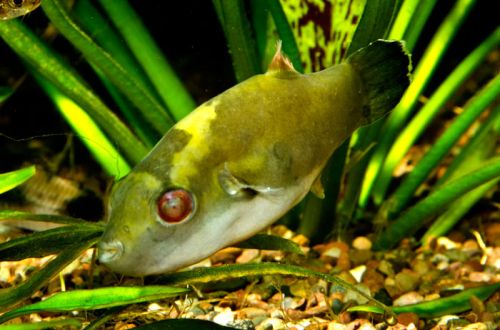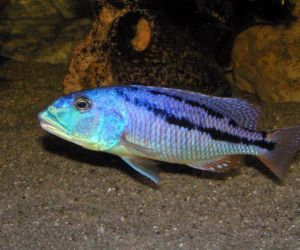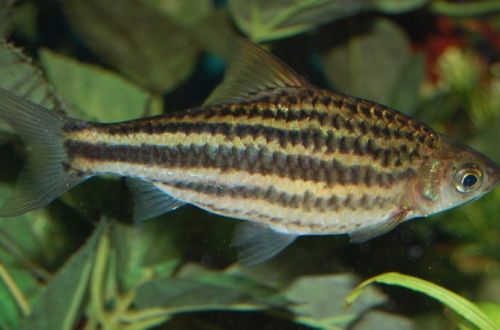
Bornean tetradon
Bornean tetradon (puffer fish), scientific name Carinotetraodon borneensis, belongs to the family Tetraodontidae (Tetradons). Not as common as its close relative, the Red-Eyed Tetradon, but sometimes comes with it in the same batch. Easy to maintain, unpretentious, except for special gastronomic needs.

Contents
Habitat
Endemic to the island of Borneo (Kalimantan), and is found only in its northern part, belonging to Malaysia, in the basins of the Rajang and Sungai rivers. Inhabits regions with a slow current. The natural habitat is characterized by an abundance of aquatic and flooded coastal vegetation.
Brief information:
- The volume of the aquarium – from 60 liters.
- Water and air temperature – 20-28°C
- Value pH — 6.0–7.5
- Water hardness – soft (1-12 dGH)
- Substrate type – sandy
- Lighting – subdued
- Brackish water – no
- Water movement – moderate
- The size of the fish is 4–5 cm.
- Nutrition – meat feed
- Temperament – conditionally peaceful
- Keeping alone in company with other fish
Description
Adult individuals reach a length of up to 4–5 cm. Sexual dimorphism is weakly expressed, males and females do not have obvious visible differences. The fish has an oval massive body and small fins. The coloration is brown with a white belly. On the head are yellow strokes, forming a figure resembling a triangle. The eyes are red.
Like all pufferfish, the fish has small spikes that are dotted with the whole body. In case of danger, the fish swells up, turning into a ball with protruding needles. In this form, the Bornean tetradon becomes much less attractive to predators.
Food
The structure of the oral apparatus in the process of evolution was transformed into something like a beak, consisting of two bone plates that grow throughout life. In nature, the fish feeds on snails, bivalves, crustaceans such as crabs and shrimp, and algae, which it scrapes off the surface of rocks. In a home aquarium, the diet should be appropriate. If the feed does not have solid components, then the “beak” will have nothing to grind on and this can lead to problems with eating.
Maintenance and care, arrangement of the aquarium
The optimal size of the aquarium for one fish starts from 60 liters. The design uses a large amount of aquatic vegetation and various shelters in the form of snags. It is worth noting that a natural tree will serve as an excellent platform for the natural growth of algae – an additional source of food for the Bornean tetradon. To give the water a characteristic tea color, leaves of Indian almond or ordinary European oak are placed on the bottom. The leaves are first dried and then soaked until they begin to sink. As it decomposes, tannins and other tannins are released. It is they who give the tea shade to the water.
High water quality is maintained by a productive filtration system and regular aquarium maintenance procedures: cleaning the soil and decoration elements, replacing part of the water with fresh water, monitoring the concentrations of hazardous substances (nitrites, nitrates, etc.).
Behavior and Compatibility
Not as aggressive as other tetradons, however, it is recommended to keep separately from other relatives. Compatible with other peaceful species, but large enough not to become an occasional pufferfish lunch. Due to its protection, it is possible to keep with large fish.
Fish diseases
In a mature aquarium ecosystem with suitable water parameters, health problems do not arise. Diseases occur when conditions deteriorate. In addition, food that does not contain solid components can cause excessive growth of the “beak”, which normally wears down on the shells of mollusks. For more information on symptoms and treatments, see the Aquarium Fish Diseases section.





